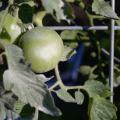Cucumbers
Cucumbers

Cucumbers are divided into two broad groups, pickling and slicing, on the basis of shape and color.
Pickling types are short and blocky and have white or black spines on the cucumber (spines are small and easily overlooked). Fruit are generally dark green at stem end and may be almost white at blossom end. Fruit with white spines turn light yellow or white when overmature. Black-spined types turn orange.
Slicing cucumbers have long fruit, are generally dark green from stem to tip, and have white spines. Grow slicing cucumbers on a trellis for straight, uniformly colored fruit.
Fruit types may actually be used interchangeably (except in vegetable shows), and the two types crosspollinate.
The normal type of cucumber plants have separate male (short stem and pollen) and female (little cucumber and pollen-receiving organ) flowers on the same plant. This condition is called monoecious. Some of the newer hybrids are described as being predominantly female, or gynoecious. These plants produce few if any male flowers. Seed packets of gynoecious hybrids generally have about 15 percent seeds of a pollinator (normal plants with male flowers) mixed in.
Until recently, all garden cucumbers required pollination for fruit to develop, and the cucumbers had seeds in them. Plant breeders are now developing seedless (parthenocarpic) varieties that develop without pollination and seeds.
All cucumbers must be harvested before blossom ends soften or fruits begin to yellow. Smaller sizes are more desirable for pickling than the larger fruit, which can be used for relish or mock spiced apple slices. Harvest slicing cucumbers before seed coats on the seeds begin to harden.
Remove all overmature, large, and poorly shaped fruit from the vines to keep plants producing.
Poor fruit shape (crooks, nubs, and balls) is caused by low soil fertility, drought, or poor pollination. A cucumber is almost 95 percent water, so lack of water affects fruit development and quality.
Bitter cucumbers result from poor growing conditions (low soil fertility, high temperatures, and drought). Varieties are now available that do not become bitter, but this is no excuse for neglecting the plants.
Cucumbers do not crosspollinate with melons, squash, or pumpkins, but they do cross with other varieties of cucumbers. This has no impact on the fruit being harvested and should be of concern only if you save seeds. Since most modern varieties are hybrids, saving seeds is not recommended.
Cucumber seedlings that are not grown in small pots or containers do not transplant easily, so plant seeds where they are to grow; or start seedlings in peat pots, pellets, or cups, and set them in the garden before the first true leaf enlarges.
Most new cucumber hybrids are resistant to major diseases. Problem-causing insects are cucumber beetles, squash bugs, and pickleworms.
Varieties
Pickling type
- Calypso—gynoecious hybrid; multiple disease resistance; uniform dark green; blocky; white spine; 56 days.
- Carolina—gynoecious hybrid; multiple disease resistance; medium-length vine; medium dark green; blocky fruit; white spine; 55 days.
Slicing type
- Ashley—straight, slightly tapered fruit; 7 to 8 inches long; 66 days.
- Cherokee—gynoecious hybrid; 7 to 71⁄2 inches long; 63 days.
- Gemini—gynoecious hybrid; multiple disease resistance; 8 to 81⁄2 inches long; 61 days.
- General Lee—tolerates cucumber mosaic virus.
- Poinsett 76—open-pollinated; monoecious; 7 to 8 inches long; multiple disease resistance.
- Salad Bush—monoecious hybrid with short (24-inch) vines; multiple disease tolerance; dark green fruit; adapted to containers, hanging baskets, and small gardens; AAS 1988.
- Slicemaster—early gynoecious hybrid with multiple disease tolerance; 8 to 9 inches long; dark green color; 61 days.
- Straight 8—white spine; AAS 1938 and still productive!
- Sweet Success—greenhouse type; seedless; 12 to 14 inches long; best grown on trellis; some disease tolerance; AAS 1983.
- Sweet Slice—hybrid; multiple disease tolerance; mild burpless; nonbitter; 10 to 12 inches long; 63 days.
- Thunder—very early; strong disease package.
Publications
News
Mississippi’s ideal growing season means gardens can yield a lot of produce, but this usually comes with the help of pesticides to combat insects and diseases.
It is vital that home gardeners know how much time must elapse between application of the product and when the food is harvested, a time frame known as the pre-harvest interval, or PHI.
Home canning is an economical way to preserve the bounty of your garden. This Q&A may answer some questions for you, whether you’re new to canning or you’ve been canning for years.
Did you know the Mississippi State University Extension Service has a laboratory that is designated to diagnose plant diseases and nematodes? Yes, it does! Learn how the Mississippi State University Extension Service Plant Diagnostic Laboratory and its scientists protect the crops that provide our food and fiber along with other home and garden crops.




